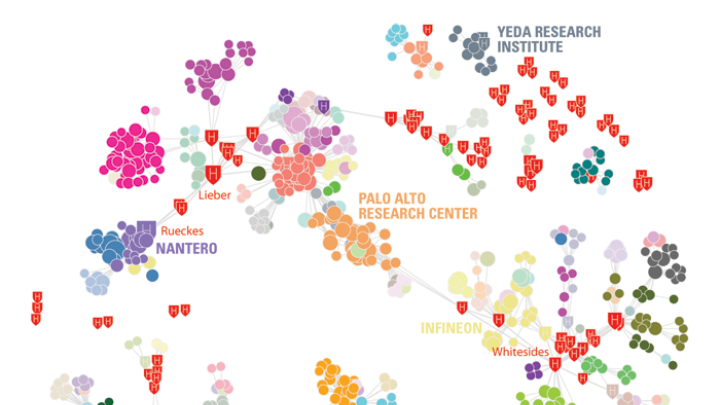Many people want to achieve success as inventors; few actually do. Lee Fleming, Weatherhead professor of business administration at Harvard Business School, is studying whether someone’s position in a network seems to matter when it comes to determining who succeeds.
Using data on all U.S. patents since 1975, his team mapped innovation networks for inventors across the country. The network of Harvard inventors who applied for patents between 2003 and 2008 is shown here, with larger nodes indicating that an inventor’s patents are frequently cited, i.e., influential; a connection between nodes indicates collaboration on an invention, measured when the inventors list themselves jointly on a patent application.
At a basic level, this map illustrates the global connections of Harvard inventors. They collaborate not only with each other, but with the distinguished Palo Alto Research Center in California; the multinational General Electric; and the Yeda Research Institute in Israel. They collaborate in a variety of domains: nanotechnology (Nantero), electronics (Infineon Technologies), and pharmaceuticals (Vertex).
This method also allowed Fleming to examine the question of what network structures seem to bolster creativity. Taking a cue from the definition of creativity as the combining of familiar ideas in unexpected ways, Fleming parsed “novel combinations”--the first time a single patent combines two subclasses of technology--from the database, which goes all the way back to 1790. He then asked what network structure surrounds people who filed patents with these novel combinations, as well as those whose inventions prompted the U.S. Patent and Trademark Office to create a new subclass. Comparing the models of the “broker”--an influential person connected to many others who don’t know each other--and the “connector”--an influential individual with a habit of introducing his collaborators to each other--he found that brokers are more likely to come up with new ideas, because they are situated at the center of a group and communication goes through them. (Flowers University Professor George Whitesides, a chemist whose work has spawned more than a dozen startups, and Hyman professor of chemistry Charles Lieber, whose projects include small-scale devices for communicating with neurons in novel ways, are clear examples of brokers in the diagram.) But brokers have a harder time getting their ideas publicized, relative to connectors. Fleming found that brokers whose ideas became influential most often were connected to a “gatekeeper” who was part of a more highly integrated network and could disseminate the idea there. (Gatekeepers in the diagram include Prakash Jagtap, who worked as a scientist at Harvard Medical School in 2001 and 2002, and now directs drug discovery at the Lexington, Massachusetts, firm Inotek; and Thomas Rueckes, Ph.D. ’01, cofounder and chief technology officer of Nantero in Woburn, Massachusetts.)
The database also enabled tracing inventor mobility, from firm to firm or university to university, across the last 35 years. Fleming and Matthew Marx, M.B.A. ’05, D.B.A. ’09 (now an assistant professor at MIT’s Sloan School of Management) determined that statewide enforcement of noncompete clauses--where companies bar employees from working for a competitor for a set period of time after leaving the employer in question--induce brain drain. States that enforce such clauses are particularly likely to lose their most productive and well-connected inventors, for whom opportunities in other states are easy to come by. An effort is under way to change Massachusetts law to prohibit the enforcement of these clauses--a change Fleming and Marx support.
In a new project, with Vetle Torvik of the University of Illinois, Fleming will integrate patent information with information on publication and collaboration from the PubMed database (which contains more than 15 million scientific journal articles), with information on government grants (for instance, from the National Institutes of Health), and with information about commercial outcomes, in a database that will be publicly available online. “We’re going to be able to trace the process of knowledge generation,” he says, “all the way from government funding, through scientific publishing and patenting, to what firms were founded and how successful they were.”








